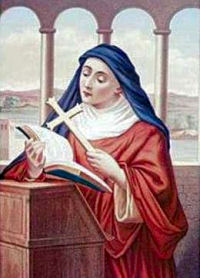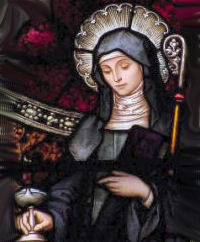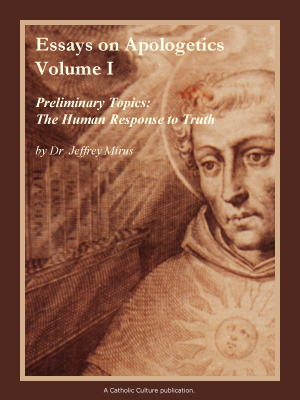Ordinary Time: February 1st
Tuesday of the Fourth Week of Ordinary Time; Feast of St. Brigid, Virgin (Ireland) (NZ, Opt. Mem.)
Other Commemorations: St. Brigid, Virgin (RM; Feast, IRE; Opt. Mem., NZ)
» Enjoy our Liturgical Seasons series of e-books!
Surnamed "the Mary of the Gael," St. Brigid was born at Faughart, near Dundalk. She took the veil in her youth and eventually founded the nunnery of Kildare, the first to be erected on Irish soil, thus becoming the spiritual mother of all Irish nuns. Around her name there have been formed hundreds of legends, which could be fittingly described as "the Little Flowers of St. Brigid," the keynote being mercy and pity for the poor.
According to the 1962 Missal of Bl. John XXIII the Extraordinary Form of the Roman Rite, today is also the feast of St. Ignatius. His feast in the Ordinary Form of the Roman Rite is celebrated on October 17.
St. Brigid
 Bridget (Brigid, Bride, Bridey) of Kildare was born around 450 into a Druid family, being the daughter of Dubhthach, court poet to King Loeghaire. At an early age, Brigid decided to become a Christian, and she eventually took vows as a nun. Together with a group of other women, she established a nunnery at Kildare. She was later joined by a community of monks led by Conlaed. Kildare had formerly been a pagan shrine where a sacred fire was kept perpetually burning. Rather than stamping out this pagan flame, Brigid and her nuns kept it burning as a Christian symbol. (This was in keeping with the general process whereby Druidism in Ireland gave way to Christianity with very little opposition, the Druids for the most part saying that their own beliefs were a partial and tentative insight into the nature of God, and that they recognized in Christianity what they had been looking for.) As an abbess, Brigid participated in several Irish councils, and her influence on the policies of the Church in Ireland was considerable.
Bridget (Brigid, Bride, Bridey) of Kildare was born around 450 into a Druid family, being the daughter of Dubhthach, court poet to King Loeghaire. At an early age, Brigid decided to become a Christian, and she eventually took vows as a nun. Together with a group of other women, she established a nunnery at Kildare. She was later joined by a community of monks led by Conlaed. Kildare had formerly been a pagan shrine where a sacred fire was kept perpetually burning. Rather than stamping out this pagan flame, Brigid and her nuns kept it burning as a Christian symbol. (This was in keeping with the general process whereby Druidism in Ireland gave way to Christianity with very little opposition, the Druids for the most part saying that their own beliefs were a partial and tentative insight into the nature of God, and that they recognized in Christianity what they had been looking for.) As an abbess, Brigid participated in several Irish councils, and her influence on the policies of the Church in Ireland was considerable.
Many stories of her younger days deal with her generosity toward the needy.
Patronage: Babies; blacksmiths; boatmen; brewers; cattle; chicken farmers; children whose parents are not married; children with abusive fathers; children born into abusive unions; dairymaids; dairy workers; fugitives; infants; mariners; midwives; milk maids; newborn babies; nuns; poets; poor; poultry farmers; poultry raisers; printing presses; sailors; scholars; travelers; watermen; Douglas, Lanarkshire, Scotland; Ivrea, Turin, Italy; Leinster, Ireland; diocese of Kildare, Ireland; County Kildare
Symbols and Representation: Abbess; usually holding a lamp or candle; often with a cow, ducks and/or geese nearby; abbess with her hand on an altar; holding a cross with a flame over her head
Highlights and Things to Do:
- Read Amy Steedman's biography of Saint Brigid of Ireland to gain a greater appreciation and devotion for this holy woman, who had a great tenderness for mothers and their children.
- Read more about St. Brigid:
- Read Saint Brigit: The Mary of the Gael (Catholic Culture Library) or go to this fascinating page St. Brigit—The Giveaway where you will find some folklore and recipes.
- Saint Brigid always recognized Christ in the sick and the poor. Visit Christ in a nursing home or hospital today, and pray for the grace of clear vision, even when you encounter Him in a distressing disguise.
- Meditate on today's beautiful reading, in 1 Corinthians 12:31-13:13. Is this the kind of love you share with your family? Pray to Saint Brigid for the grace to be patient, kind, and gentle with those entrusted to your care.
- Like so many other saints, St. Brigid's relics have an adventurous and sometimes disputed history. Until 1538, her relics, with Sts. Patrick and Columba, were at Downpatrick Cathedral until 1538, when the relics of the saints were desecrated and destroyed during the deputyship of Lord Grey, except for St. Brigid's head, which was taken to the Franciscan monastery of Neustadt, in Austria.
In 1587 it was presented to the church Igreja de São Roque (Church of St Roch) by Emperor Rudolph II, that is where a frontal part of her skull is still venerated. An occipital part of the skull preserved in the Igreja São João Batista (Church of St. John the Baptist), on the Lumiar, and has been venerated since the 13th century.
Wikipedia has several other stories of some other relics scattered about the world.
- For more recipes go to Brigid's Day Foods and Catholic Cuisine.
- See How to Make a Traditional St. Brigid's Cross or these directions to make a St. Brigid's Cross.








